The rock stars of Te Hūpēnui are at their very best when surrounded by their community
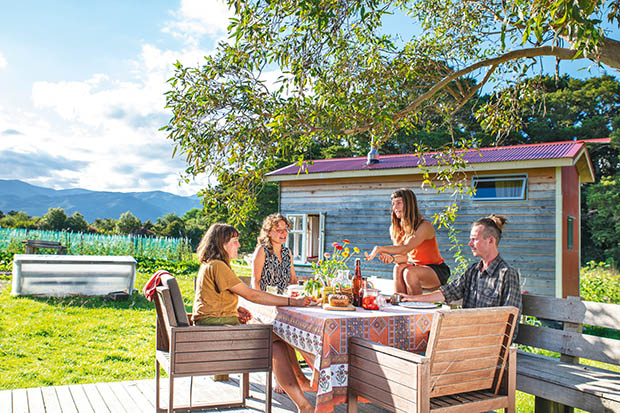
It takes a village to raise a child, and it turns out a village can also help four young growers in a time of disaster to start a community-minded business with a sustainable food strategy that benefits everyone.
Words: Nadene Hall Photos: Ehsan Hazaveh
Who: Elle Farr, Lise Van Laere, Saskia Wanklyn & Sheldon Levet
What: Vagabond Veges, community-supported agriculture business
Where: Te Hūpēnui | Greytown, 80km north-east of Wellington
The neighbours were the first to notice the rock harvesting. Four young people in a paddock, digging up rocks like they were potatoes, if potatoes were harvested using crowbars.
To the surprise of the diggers – Elle Farr, Lisa Van Laere, Saskia Wanklyn, and Sheldon Levet – their neighbours were curious and encouraging.
“I thought we’d get a bit more pushback than we did, (they’d think) crazy young hippies, or something,” laughs Sheldon. “But most of our neighbours were keen to come and talk. In a weird way, (the digging) also brought us some credit with locals. People driving past would see these four young, crazy people digging rocks all day, but they also were slowly seeing something emerge. They could see we’re trying to live a dream that we’re passionate about. After it had been going on for a while, I think people started to take us more seriously too.”
The four friends had wanted to start a growing business for a while. But with land so expensive, they were beginning to think it would never happen. Elle and Saskia had both moved away to new farming jobs when their mutual friend Justin made them an offer of a lifetime. Would they like to lease some of his family’s block on the outskirts of Greytown, complete with a little cottage to live in?
“We’re leasing the land off Justin but it’s a long term lease, five years with a possible extension to 15 years. He knows young people are pretty much locked out of buying a property, and he really wanted to be part of a solution.”
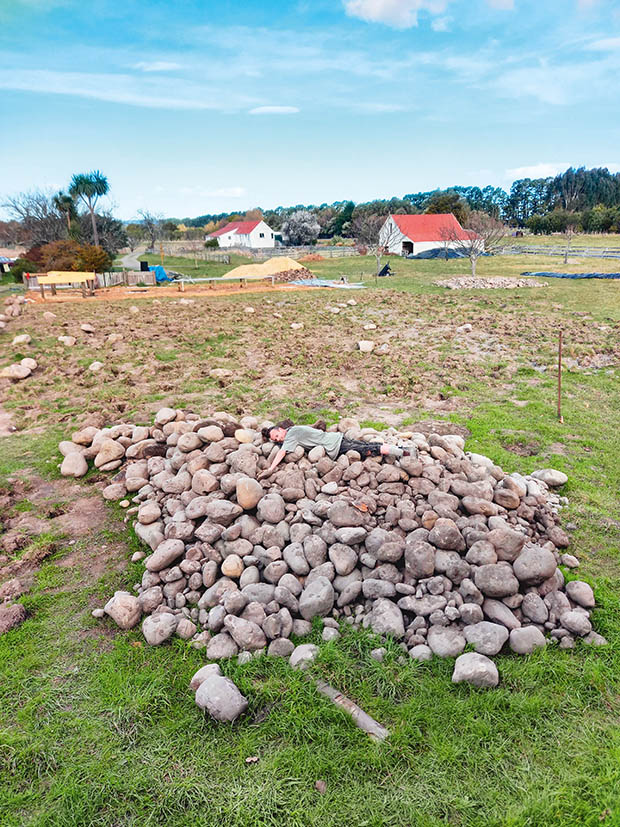
Sheldon on the rocks, almost all of them dug up by hand using crowbars and forks. Instagram: @vagabond.veges
And that’s how the four friends ended up digging rocks through the autumn and winter of 2021 to create the gardens that form the heart of their growing dream.
Their business, Vagabond Veges, is a few minutes’ drive from the main street of Te Hūpēnui (Greytown), over the Remutaka Hill from Wellington. Their farm is the former bed of the nearby Waiohine River, so when Sheldon talks about digging up rocks, you might be envisaging grapefruit-size stones, some bigger, some smaller. Turns out, no.
The picture above of Sheldon sprawled, exhausted – captioned ‘Sheldon on the rocks’ on their Instagram page – shows the size of the challenge they faced.
“We had a tractor come through to loosen the surface rocks, that wasn’t too bad. Then we got someone in with a tractor to rip the soil.”
A ‘ripper’ is made of thick, toughened steel and is dragged behind a large tractor, lifting, slicing and aerating the soil. They thought it would make the rock harvest easier. The rocks had other ideas, the ripper was damaged, and it was back to digging with crowbars and forks.
In the end, the team sent out invites to the world’s quietest rock party. Friends and family turned up to help them clear 900m² of soil, so they could start planting for their first season.
When they weren’t digging, the Vagabonds had been busy constructing a beautiful tunnel house they’d bought with their meagre funds to house their spring seedlings.
A few days after they finished it, it was gone. A massive storm hit the Wairarapa, rain coming in sideways, wind gusts hitting up to 160km/h, which tore the plastic frame apart in the early morning hours.
“One hoop had already completely bent, loose ropes flying, reinforcing bar bent and ripped from the ground. We managed to save most of our seedlings, but it was so windy and unsafe that all we could do was stand back and let the chaos happen.”
THE COMEBACK
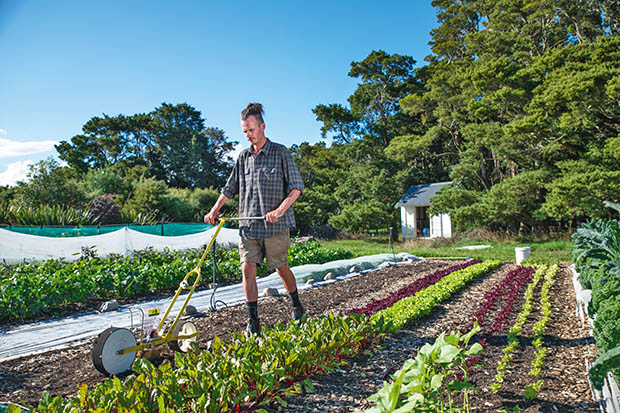
The result. The soil is (almost) clear of rocks to a depth of 20cm, and the Vagabonds add compost to the top to keep it healthy.
But once the chaos subsided, the Vagabonds struck gold. A local grower offered the use of one of his tunnel houses to keep their seedlings going until planting time. They also learned a lot of valuable lessons, says Lise.
“We didn’t know what the climate was going to be like here, and it turns out, in late winter, early spring, it’s really windy.
“(The big storm) delayed us by 3-4 months, so while it was horrible, it was also really good. First, the rocks slowed us down and we couldn’t do other things that could have been undone by the wind, and (the storm) gave us more time to plan.”
However, they’d used up the last of their savings on the tunnel house. A friend suggested they crowdfund to buy a replacement.
“We were really hesitant,” says Lise. “We could only think maybe 20 friends and family would donate to it.”
In their crowdfunding pitch, the Vagabonds described how they wanted to create an organic market garden to support Greytown locals with a fresh vegetable subscription service. They talked about what they needed (a tunnel house), what they wanted (a washing system and packing house), and how much their dream meant to them.
Things quickly became chaotic.
“It was insane,” says Sheldon. “We initially thought we’d be lucky to reach $20,000 (over eight weeks). We broke that in three days, so we had champagne to celebrate – some really cheap champagne! – sitting on top of a pile of woodchips.
“We were blown away, not only by the number of locals and other people we knew, but by the number of people we didn’t know. We had people from all over the country, from Auckland, from Waiheke Island. We realised there was something really powerful in the message we were trying to convey.”
And the number kept rising: $25,000, $30,000, $40,000.
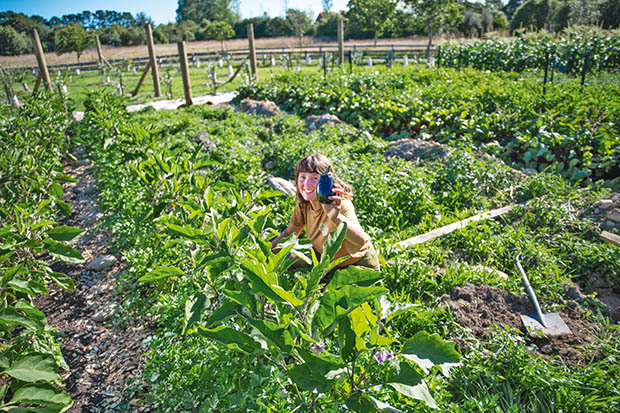
Two days before the crowdfund deadline, Lise and Sheldon decided to go on an overnight bush tramp to blow off some steam. When they got back and checked the final tally, their mouths dropped open.
“It had doubled in two days,” says Sheldon. “We ended up with 264 people who raised almost $80,000 for us. Even more than the money was the boost to our morale. We went from slugging away, quite isolated, not knowing many people, to feeling really supported, all these people knowing about us, checking in with us.”
The first step was to develop a new plan that incorporated the lessons from the chaos of their first few months.
They started by planting out the 900m² of cleared soil which is divided into 52 beds.
“We applied 10cm of compost, and we planted into it,” says Lise. “We discovered some rocks had gotten away from us, and we thought, ‘oh well, some carrots might not grow straight,’ but the carrots were fine, we’ve never grown such straight carrots.”
Their first season crop count was 35.
“Because we’re doing a CSA, we need lots of varieties, and we’ve probably gone a bit overboard, but it meant we could look at what crops work in our soil and climate, do customers like them, so hopefully we can narrow them down a bit. We knew from Sheldon’s growing knowledge and Elle’s farm work that some would be great and others wouldn’t work at all.”
Their toughest crop turned out to be spinach – “it just keeps bolting like mad” – while their best were the cherry tomatoes.
“Considering we didn’t have our tunnel house, they were outside and they did really well, probably because of the rock soil and it’s also really hot here.
“Also our radish crop did unexpectedly well, they grew really big and sweet. When we went to our first market, it was like 60% of our crops for sale were radishes and I was terrified, ‘what if people don’t like radishes?’ But they just flew off the shelf, it would seem Greytown likes radishes.”
HOW FOUR FRIENDS GO FARMING
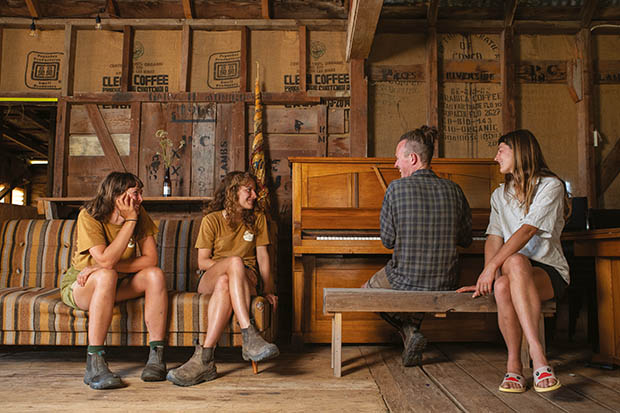
Lise and Sheldon live in the little cottage that doubles as the kitchen, lunchroom, and work office, while Elle and Saskia have bedrooms in a tiny house parked up alongside it.
The four have been friends for many years and had long discussed working together.
“Part of our reason for doing this with four people was to prove it was possible,” says Sheldon. “There’s a lot of burnout among farmers, and not many young people want to start growing. We wanted to show it’s possible to pay four people a wage and make it work.”
They’ve naturally fallen into certain roles based on their experience. Sheldon and Elle had both worked on farms, and they do a lot of the crop planning and field management. Saskia is passionate about flowers, so she’s growing organic flowers, alongside garden work.
“There’s a lot of managing relationships,” says Lise. “We’ve gone through some rocky moments, but we’re getting there. We’ve all slotted in to where we want to be, and part of it is letting go, allowing each other to have autonomy in the bits we want to do.”
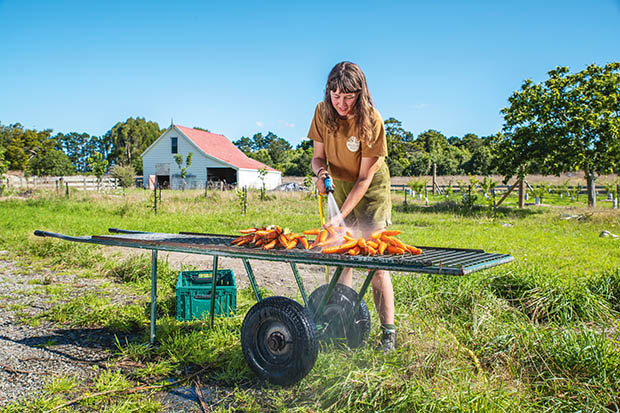
“There’s also a big trust component,” says Sheldon. “We’re making sure everyone feels validated. Even things like taking time off, how do you feel ok taking time off when you can see everyone else is working?
“We have weekly check-ins to see where we’re at, we do a ‘temperature check’, or an internal weather report on how we’re feeling.”
They also face the stresses of running their first small business, says Elle.
“We didn’t see the hardship coming up as it did, that’s been a roller coaster. But we’ve had lots of support and lots of love – it’s been quite hard at times.
“It has also been hard becoming our own bosses. We’ve all gone from having some degree of support, we’ve always worked for someone who has knowledge. But here, we’ve had to be and do it all ourselves, which is the awesome and most exciting part.”
THE RESULT: THE VAGABOND VEGE CSA
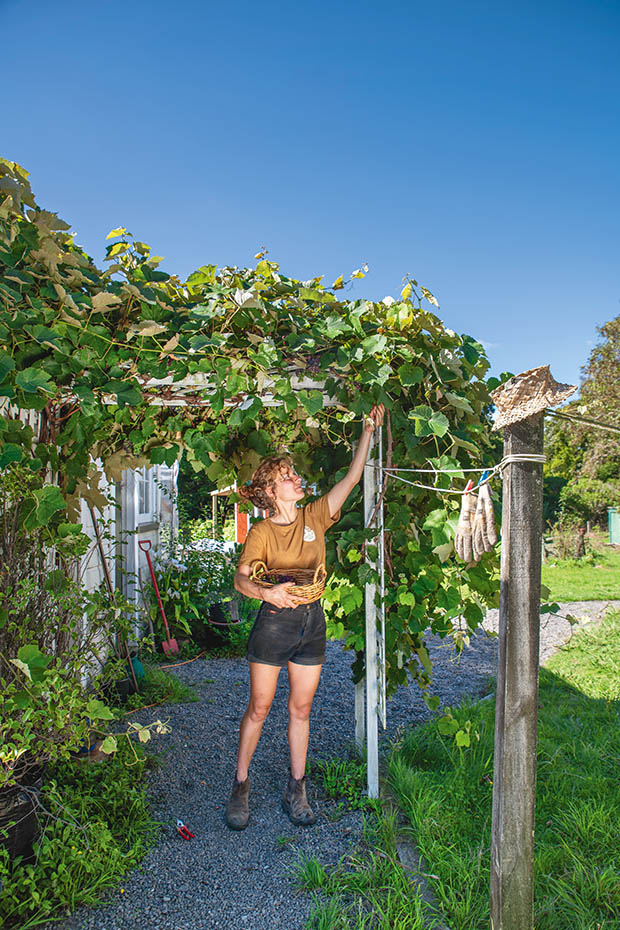
From their rocky start less than a year ago, the Vagabonds now grow enough vegetables to feed 35 families, supply the local farmer’s market, and send extra to Little Farms in nearby Masterton.
“They’re like an aggregator of little organic farms,” says Sheldon. “They’re farmers, and they want to put the spotlight on other growers too. They’re moving to new land and transitioning their garden, so we’re supplying some produce to them, and it’s a win-win for both of us and their customers.”
However, their main focus is the weekly subscription box full of seasonal vegetables. The Vagabonds offer two box sizes (small $30, large $50), and locals can sign up for a month, six months, or a year. The vegetable supply varies week by week, and you get what you’re given. That can be challenging for people new to the CSA, so the team also provides recipe cards.
There’s a spectrum of CSAs around the world, and their one is Kiwi, says Sheldon.
“In Germany, parts of the US, and I think in Ireland, everyone knows what a CSA is, and it’s usually pay upfront on January 1st and receive 12 months of vegetables. That wouldn’t float in this country because CSAs are pretty new. We wanted to work out different commitment periods and how people could pay for it, knowing most people don’t have the money upfront for 12 months of vegetables.”
The trick to having enough food to fill each box every week, is spreadsheets.
“Well, it’s part spreadsheets, part guesswork,” says Sheldon. “There are so many schools of thought, like ‘I want to harvest 45 heads of broccoli on this day’, then work backwards from there.
“We had a massive crop plan, we’d planned sowings, and then when the storm hit, that all went to shit, so we’ve been doing ad hoc planning. For example, there’s a really small window for sowing tomatoes, so we did the first one in late August, and those plants will produce for hopefully two months – that’s fairly predictable.
“But then how many beetroot do we want each week? Should we sow in two weeks’ time or three?”
Over summer, there are key weekly crops, such as lettuce, beetroot, carrots, and spinach. In autumn, they’re removing old plants and sowing new ones to ensure there’s enough for 30 boxes a week.
Their teachers have come from around the world, says Sheldon.
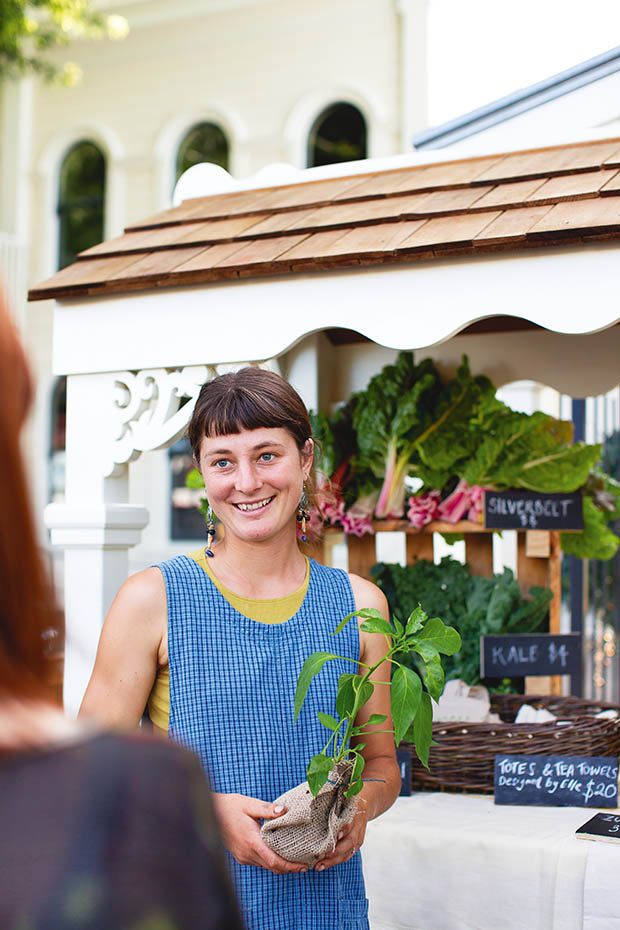
The community has been an enormous support. Each Sunday, they sell their organic crops using one of the stalls set up for locally-produced goods by Millie Blackwell of Mrs Blackwell’s Village Bookshop on Greytown’s main street.
“When you’ve been farming for 30 years, you can probably figure it out in your head, but for us, it’s lots of spreadsheets, lots of talking to other growers. Some people online have open-sourced their systems. We’ve read a lot of books, watched a lot of YouTube. Even if you don’t know much about growing, it’s possible to learn it all online.”
One of the fundamentals of a CSA is encouraging subscribers to come on farm to see what’s going on and learn more about growing their own food.
“We want to show people that sometimes it’s hard to grow the things they want, some like beans are really labour-intensive,” says Sheldon. “Also that it’s quite an unpredictable way of earning an income and that the food supply is really unstable. People have been guarded from that, they don’t see the instability.”
Sheldon used to help run a CSA in Wellington, and says it was interesting to see how people became more involved over time as they began to understand CSA principles. The Vagabonds can see the same thing is already starting for their business too.
“A subscription service provides us with so much stability, and when people sign up, they know they’re supporting us and our farm. They know where their food comes from, they can rock up and talk to us at any time and see what’s going on. They meet other members, and learn about new things. It’s really lovely.”
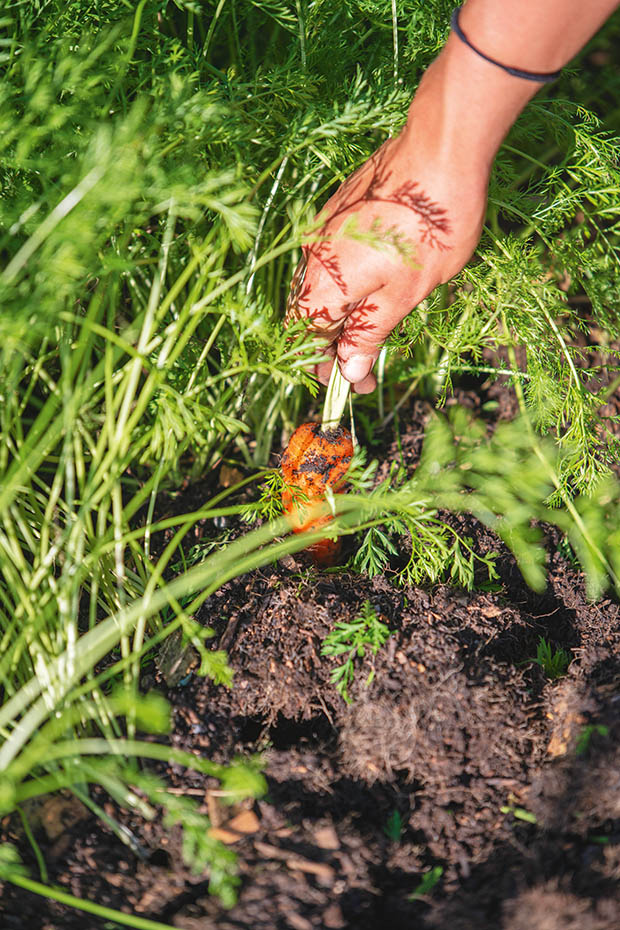
In a way, the experience of going through a pandemic has highlighted the need for locals to serve their community, says Sheldon.
“COVID highlighted the international supply chains, it’s hard or impossible to get things. People started thinking maybe someone on my street could make this for me, grow this for me. I think there’s a growing movement of people saying, ‘why don’t I just make this thing and supply my community?’ For example, our neighbour has these fabulous lime trees, so she supplies them to all the local growers to sell.
“It’s a way of having a bit more control over what’s happening, it highlights where your money goes, to another local, instead of really far off.”
In Europe and Canada, there are village agrarian groups, where small communities pool their resources to help each other.
“For example, people with a spare paddock get connected with someone who wants to plant a market garden, and it’s starting here too.”
The Vagabonds are keen to show other growers and communities that a CSA can be a profitable venture and a sustainable use of land. Even better, when they work together and support each other, everyone can share in the good fortune.
“Even with a CSA half an hour up the road from us, why compete?” says Sheldon. “It’s so strange the really big growers don’t work together more to set better pricing, flip the economics on its head, instead of being dictated a price that’s not profitable. I mean, brown onions have been so unprofitable for so long, they get exported. If we work together locally, we can set prices that work for all of us.
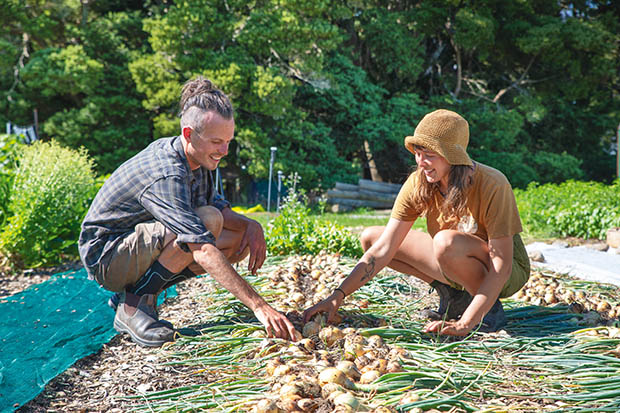
Sheldon and Elle sorting through the onion crop. The Vagabonds use a system of spreadsheets to plan crops, and a big whiteboard to plan the weekly workflow.
“We’ve had so much help from other small growers, we’ve been talking with them about collaborating more, working out what’s our forte, what’s their forte.”
Their goal is to increase the number of subscribers paying for a box of vegetables per week for 12 months, and they’re feeling positive despite what they’ve faced so far.
“The biggest challenge when things have been bad, when they’ve gone wrong, is staying positive and being friends, and we’ve done that,” says Lise. “It’s really nice to have this kind of support structure. Sheldon and I are partners, but we also have our friends here, so when something goes wrong, it’s four brains, and we have each other’s backs. If you forget to sow something, someone else will notice. We’re slowly finding our own strengths more, our own nooks.”
Almost a year into their journey, the Vagabonds already have good systems. Each Monday, they gather to plan the week.
“To begin, the facilitator of that week picks a book from the book case (at random) and reads out a passage. Not sure why, but it’s what’s done,” says Lise. “With colour coded pens we fill in our whiteboard which acts as our weekly diary. Meetings, visitors, errand runs to Whakaoriori/Masterton, days off, planned nights alone – we spend a lot of time together.”
Everyone is assigned a role: nursery management, watering, sowing/thinning, crop planning, mowing.
On Wednesdays, they do a check-in.
“The wellbeing master (a new thing we’re trying) starts and we talk about our weather (mood), temperature (energy, need for time off), needs for the coming week, and finish off with an affirmation – something we appreciate about each other.”
They’re also planning more infrastructure. They’ve already installed a series of big windbreaks to protect their crops from gale force storms, with more planned. They’re constructing a dedicated washing and packing area in a shed.
More rock harvesting will be required to extend their growing beds so they can reach their goal.
“Our plan is to have two fields in production, a healthy time-off schedule, to be feeding 100 families through our CSA, and selling to some wholesale suppliers,” says Lise. “That’s our dream scheme.” •
WHAT IS A CSA?
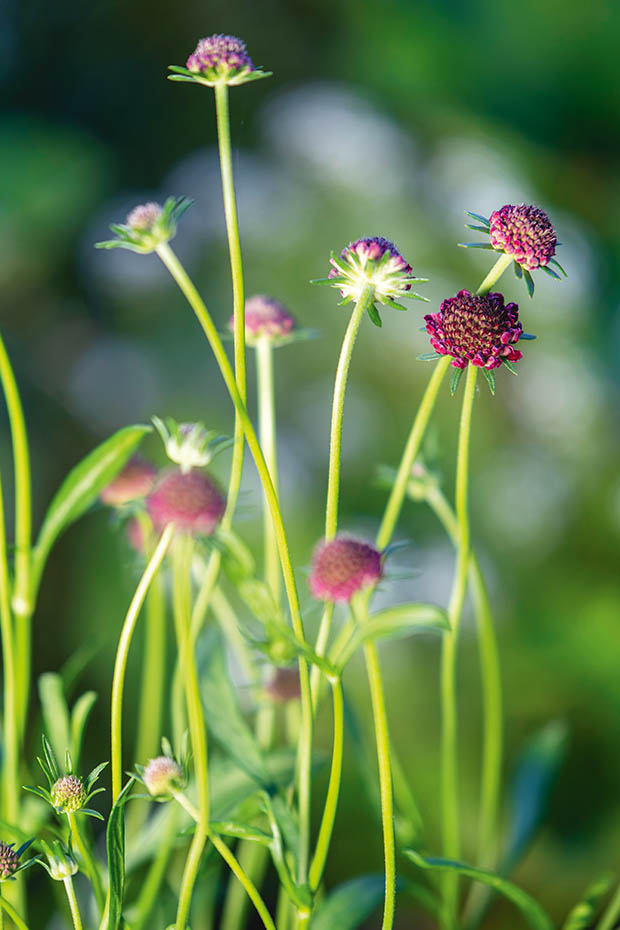
Saskia’s flowerbeds provide pollination, edibles, and beauty. This summer, she produced bunches for CSA members, the market, a local shop, and wholesalers.
Community Supported Agriculture (CSA) schemes vary in how they work. Generally, it’s a direct relationship between a farmer and the people who eat the food the farmer produces.
CSA farms are directly accountable to their consumer members. They strive to provide fresh, high-quality food and typically use natural farming and regenerative methods.
There tends to be more people working on CSA farms than on conventional farms, and some CSAs encourage members to work on the farm in exchange for a portion of their membership costs.
CSA is a shared commitment to building a more local and equitable agricultural system, one that allows farmers to focus on good farming practices and still maintain productive and profitable farms.
Love this story? Subscribe now!
 This article first appeared in NZ Lifestyle Block Magazine.
This article first appeared in NZ Lifestyle Block Magazine.
